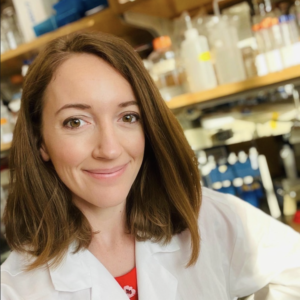New Vision Research Focus - Rachel Bennett

I grew up in Phoenix, Arizona and have been interested in the brain since I took a high school field trip to a brain bank, which stores tissues donated to research. I remember one of the scientists pulling out a small microscope and a slide with a tiny piece of cortex on it that had been stained for Alzheimer’s disease plaques. On the slide we saw neurons and cells packed together with splotchy, plaque-like protein deposits spread throughout the section. When I looked at it, it felt like an “ah-ha!” moment: using a few simple science techniques, researchers could make Alzheimer’s disease changes visible. Being able to see the disease drove me to ask questions about how the brain works and specifically, what causes it to stop working in Alzheimer’s disease.
After completing my Ph.D. in Neuroscience at Washington University in St. Louis, I was drawn to Dr. Bradley Hyman’s lab at the MassGeneral Institute of Neurodegenerative Disease as a postdoctoral researcher because he’s at the forefront of developing microscopy tools to help visualize changes taking place in the brain. As a new fellow in 2014, I initially focused on neurons and watching what happens to them as Alzheimer’s proteins accumulate. However, sitting at the microscope one day, I noticed that blood vessels in diseased brain looked different than in a healthy brain. This observation set us on a path to exploring new ideas about how the brain (and not just neurons!) is altered by disease and I am increasingly fascinated by the incredibly interesting biology of brain vasculature, which was the topic for my CCAD application.
The collegial support, encouragement, and funding from the CCAD came at a critical time as I was in transition from my postdoctoral work to launching my own research group at MassGeneral Hospital and Harvard Medical School in 2019. Starting new projects like this is particularly difficult for an early-stage investigator such as myself. Every aspect of my research must be carefully planned and budgeted. This means that interesting observations can’t always be explored immediately, as the typical process of writing and applying for grants takes a minimum of one year from start to finish. Funding from the CCAD allowed me the flexibility to work on the important questions right away.
As I move forward with my career, my goal is to maintain this CCAD-inspired mindset and help think of new ways to treat Alzheimer’s disease outside of the traditional approach of targeting plaques and tangles directly. Along these lines, I am continuing investigations that stemmed from this original project and focus on blood vessels in the brain. Blood vessels play an important role in supplying the brain with the oxygen and nutrients necessary to keep neurons alive, and the blood vessels in your brain are unlike those found in other parts of the body. The cells that make up blood vessels can also be affected by the same proteins that accumulate in Alzheimer’s disease which causes them to become inflamed, changing their shape and recruiting white blood cells to their surface. Like clogging a pipe, these changes restrict blood flow and could have devastating consequences to brain health. Identifying these important vascular changes has led to an innovative way of thinking about how we might treat Alzheimer’s disease: if we can find treatments that reduce inflammation and white blood cell “clogs” in brain vasculature, we might be able to slow or prevent neuronal loss.
Towards this aim, my lab is rapidly expanding—just this year we added two new postdoctoral researchers and a research technician. Together, this team will carry out a NIH R01 funded project to better understand changes taking place in human Alzheimer’s brain vasculature. Just this year we were able to complete a massive single-nucleus RNAseq study examining multiple brain regions across a spectrum of pathological disease stages. Published in the Journal of Neuroscience, these gene signatures confirm many of our initial observations from Alzheimer’s models and provide new blood vessel-related disease-targets for us to explore. Following advice I had originally received from CCAD members, I am also working closely with colleagues who perform MRI and PET imaging to developing new, targeted methods to visualize these vascular changes in patients so that we might use new or existing drugs to reverse these vascular problems. In the future, I hope we might see this project evolve into a clinical trial and a treatment for Alzheimer’s.
